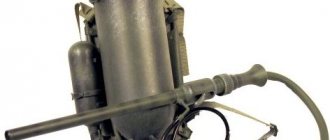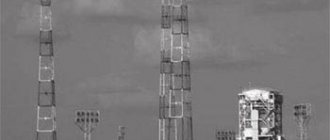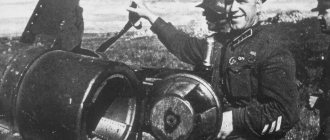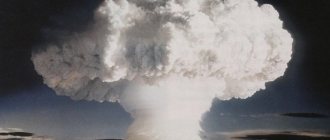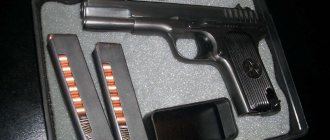The first flamethrowers
The flamethrower appeared on the battlefield during the First World War, when trench warfare forced the warring parties to look for new means of hitting the enemy. The first massive use of flamethrowers by German troops on the Eastern Front was noted in November 1916 near Baranovichi in Belarus. By the end of the First World War, Russia began producing a flamethrower that was quite advanced for its time, designed by Stranden Povarnin and Stolitsa (SPS). In total, about 300 units were produced. However, during the First World War they did not have time to use it. The first combat use of flamethrowers was recorded later during the Civil War during the fighting on the Kakhovka bridgehead. During the interwar period, the development of flamethrowers in the USSR was given far and away the last place.
General view of the ROKS-3 flamethrower. (yaplakal.com)
The battles on Lake Khasan, the Khalkhin Gol River, and especially the battles of the Soviet-Finnish War showed the effectiveness of flamethrowers in breaking through prepared enemy defenses. These were the actions of Soviet flamethrower tanks. But work continued on the creation of backpack flamethrowers. In 1940, the ROKS-1 flamethrower was put into service, and at the very beginning of the Great Patriotic War, ROKS-2. This weapon was used sporadically in the initial period of the Great Patriotic War.
Links
Rifles and carbines Mosin rifle • ABC-36 • SVT-38/40 • SKS Submachine guns Tokarev submachine gun • PPD-34/38/40 • PPSh • PPS-43 • LAD Machine guns Maxim machine gun • • • • DS-39 • SG-43 • • DShK Grenades Grenade model 1914/30 • F-1 • RGD-33 • RG-41 • VPGS-41 • RPG-40 • RPG-41 • RG-42 • RPG-43 • RPG-6 Anti-tank rifles PTRD • PTRS • Rukavishnikov PTR • ZIF-11 Flamethrowers FOG-2 • ROKS-2/ROKS-3 • 125-mm ampoule launcher model 1941 Rifle grenade launchers Dyakonov's grenade launcher • Tsukerman's bottle launcher • Inochkin's bottle launcher Ammo 7.62×25 mm TT • 7.63×25 mm Mauser • 7.62×38 mm Nagant • 7.62×54 mm R • 12.7×108 mm • 14.5×114 mm
Flamethrower design: main characteristics of ROKS-3
In 1942, the ROKS-3 backpack flamethrower, created by V.N. Klyuev and M.P. Sergeev, entered service with the Red Army, which was superior to previous models in its reliability and efficiency. ROKS-3 had a tank with a capacity of 10 liters. Flame throwing was carried out using a special fire cannon. The total weight of the flamethrower was 23 kg. The firing range was 35 meters. The mixture was released using compressed air. Without reloading it was possible to fire one or two long or 6-8 short shots. In a number of cases, the gun-pistol was replaced by a fire-pistol, which was convenient for fighting in trenches and increased the mobility of the fighter. But at the same time, the flamethrowing range decreased by 10 meters.
Flamethrower on a Kukryniksy poster, 1941 (pobedarf.ru)
When defeating enemy equipment in a street battle, the "Roxists" used ambush tactics - they tried to take positions on the second floors of buildings and destroyed enemy equipment with the concentrated action of several flamethrowers from a distance of 20-30 meters. The staff organization of units equipped with backpack flamethrowers was constantly changing. As the number of flamethrowers increased, special battalions with considerable power began to be created. Thus, the battalion’s 540 backpack flamethrowers could create an almost continuous wall of fire along a 3.5 km section of the front. Although the massive use of flamethrowers was a relatively infrequent occurrence. More often, flamethrowers acted in a decentralized manner as part of small assault groups and even individually, which provided the secrecy necessary for approaching the enemy.
From Stalingrad to Berlin: combat use of ROKS-3
The beginning of mass use was the events of the Battle of Stalingrad. Flamethrowers turned out to be especially effective in street battles, when large military units could not turn around and the parties switched to small assault groups of 5-7 to 10-12 people. In addition to automatic small arms and grenades, the assault group was armed with 1-2 backpack flamethrowers. On rough terrain, the "Roxists" had the opportunity to quietly approach the enemy, and surprise of use was the main factor of success. During battles in open areas, the attack of flamethrower units was usually preceded by artillery preparation, under the cover of which the assault units were able to approach enemy positions.
The use of flamethrowers often had a strong demoralizing effect on the enemy. Often, enemy soldiers who survived the use of flamethrowers tried to leave cover and were destroyed with small arms. At the final stage of the war, flamethrower units actively operated during heavy street fighting in Budapest, Breslau, Konigsberg and Berlin.
Soviet flamethrowers change position. Source: art-apple.ru
But the backpack flamethrower, in addition to obvious advantages, also had a number of disadvantages. Firstly, the relatively short firing distance that the flamethrower needed to get closer to the target. At the same time, a fighter with 10 liters of fire mixture behind him risked much more than ordinary infantrymen - if a stray bullet or shrapnel hit a tank with liquid, the flamethrower would turn into a living torch. At the same time, the fighters of the flamethrower units always belonged to the category of military personnel towards whom the enemy had a special attitude - as a rule, they were not taken prisoner.
In some cases, external factors - for example, a strong headwind - precluded the use of a backpack flamethrower. The flamethrower itself required careful handling and care. At the same time, in wartime conditions it was not always possible to achieve high-quality weapons production. Tactically, attempts to use "Roxists" as (or instead of) conventional rifle units were unsuccessful.
How effective were the flamethrower units? According to official statistics, during the Great Patriotic War, with the help of backpack flamethrowers, Soviet soldiers destroyed 33 thousand enemy soldiers, 120 tanks, suppressed 3 thousand firing points, and burned out 2,300 fortified buildings. Thus, during the capture of Poznan in February 1945, the assault group under the command of the commander of the backpack flamethrower squad, Sergeant N. D. Khitrov, burned out 46 enemy fortified points, destroying up to 400 German soldiers.
In fine art, backpack flamethrowers are found on posters from the Great Patriotic War. In feature films about war, they are relatively rare - for example, one of the final episodes of the film “The Third Strike” (1948), which shows the massive use of flamethrowers during the assault on Sapun Mountain.
FOGs and ROKSs in service in the Red Army
Throughout the centuries-old history of mankind, fire has constantly served as a means of destroying enemy manpower and military property, disabling its combat assets, and destroying buildings and engineering structures. And now incendiary weapons occupy an important place in the overall weapons system. Incendiary weapons received significant development during the First and especially the Second World War.
From the first days of the war, various incendiary weapons occupied a prominent place in the arsenal of combat weapons of the Red Army: aerial bombs; artillery shells and mines; grenades, bottles, cartridges, ampoules, checkers; as well as flamethrower weapons: hand-held, tank and high-explosive flamethrowers; fire mines and barriers, various sabotage incendiary means, etc.
The experience of the Great Patriotic War convincingly showed that Soviet pyrotechnic means were not inferior to foreign ones in terms of efficiency, simplicity of design and manufacturability, and in many cases surpassed them.
The success of flamethrower units of all types largely depended on how accurately the target locations were identified, the safest routes to approach the flamethrowing line were correctly selected, and reliable communications were established with supporting units. The night operations of flamethrowers were especially effective.
High-explosive flamethrowers were melee weapons designed to destroy enemy personnel and tanks with a jet of burning fire mixture.
A.P.
Ionov Soviet designers, engineers, and workers created two types of high-explosive flamethrowers: FOG-1 and FOG-2 (the latter is the main model). They were created on the basis of viscous fire mixtures (flammable liquids) No. 1 and 3, developed by the talented chemical engineer A. Ionov. Back in 1938, he began research on the synthesis of powdered thickeners to obtain viscous fire mixtures. Designers and officers of the Main Military Chemical Directorate of the Red Army took a creative part in these works. The development of the technology for producing powdered thickener OP-2 and viscous fire mixtures based on it, as well as field tests of fire mixtures, were completed in 1939. The result was a twofold increase in the range of the burning jet when fired from a standard tank flamethrower.
In 1941, the Soviet government decided to establish mass production of the OP-2 thickener and viscous fire mixtures based on it at the factories of the People's Commissariat of Food Industry. Under the leadership of the chief engineer of one of the main departments of this People's Commissariat, Naumenko, many soap factories began to produce powdered thickener OP-2, and at distilleries - a viscous fire mixture and bottled it. A number of confectionery factories began preparing fuses for incendiary bottles. Ion's Red Army used viscous fire mixtures in flamethrowers of all types.
In July of the same year, the FOG-1 high-explosive flamethrower successfully passed field tests, was adopted by the Red Army and put into mass production. The outbreak of war required speeding up the production of FOG-1 flamethrowers.
During the fighting in the initial period of the war, the FOG-1 flamethrower revealed some shortcomings. The presence of two separate chambers (for the powder charge and the incendiary bomb) sometimes led to one of the fuses not firing, and, therefore, the fire mixture did not ignite. In addition, the flamethrower's fire hose extended beyond its dimensions, which made it difficult to covertly deliver the latter to the position.
To eliminate the shortcomings, the designers proposed placing the charge and the saber in one glass and reducing the fire hose, and also developed a new design of the impact device, which made it possible to activate the flamethrower mechanically using a simplified mine fuse (MUF) and a special ignition cartridge.
Already at the beginning of 1942, the design of FOG-1 was modified taking into account proposals from the troops, and in May its modification was tested. After modernization, the flamethrower was named FOG-2. From the end of 1942, the FOG-2 flamethrower began to enter service with the troops. The structure of the high-explosive flamethrower FOG-2: 1. Tank.
2. Trunnion. 3. Ring. 4. Siphon tube. 5. Fire hose. 6.Nozzle. 7. Membrane. 8. Union nut. 9. Glass. 10. Handle The flamethrower is very simple in design. Its tank had two holes. A glass for a powder charge was welded into one of them, and a siphon pipe was mounted in the other. The upper part of the pipe ended in a nozzle, on which a membrane was attached with a union nut, covering its opening.
When equipping a flamethrower, a powder charge was placed in the charging cup, and an incendiary bomb was placed on top of it. An electric igniter or a mechanical igniter with a tension or pressure impact device was inserted into the bomb.
When the fuse (or igniter) was triggered, the incendiary bomb ignited, igniting the powder charge. The flame formed when the checker burned was thrown out in the form of a torch through the pilot hole in the glass. The gases released during the combustion of the powder charge squeezed the fire mixture through the siphon pipe to the membrane. The membrane was cut off due to high pressure, and the fire mixture was thrown out of the nozzle. Flying out of it, it was ignited by the fire of an incendiary bomb and flew towards the target in the form of a burning jet. At the bottom of the tank and to the top of the siphon pipe, two trunnions with rings were welded. A cord was attached to the rings, with the help of which the flamethrowers rolled freely along the ground and were secretly delivered to the position. The high-explosive flamethrower allowed only one shot, after which it was reloaded and the tank was filled with freshly prepared viscous fire mixture.
At firing positions, flamethrower tanks were firmly strengthened in the ground with wedges, in trenches torn off for each flamethrower. If there were vertical supports (trees, pillars, pillars), flamethrowers were attached to them with wire or special clamps. The fire nozzles of the flamethrowers were directed so that the jets of neighboring flamethrowers overlapped each other (ensuring the destruction of targets both in front and on the flanks).
In August - September 1941, special flamethrower units were formed and prepared for combat operations - separate companies of high-explosive flamethrowers (ORFO), whose actions were highly effective. At the beginning of October of the same year, the first 50 companies were sent from the reserve of the Supreme High Command to the active fronts and to the Moscow defense zone. A separate company of high-explosive flamethrowers consisted of three platoons of three sections each. The company was armed with 180 flamethrowers (60 in a platoon and 20 in a squad) and small arms. To transport flamethrowers and a supply of ammunition, the company had 32 paired horse-drawn carts.
Units and subunits of high-explosive flamethrowers were intended to destroy enemy tanks and manpower. Their defensive tasks were multifaceted: to cover tank-dangerous areas, repel massive attacks by enemy tanks and infantry, protect the flanks and joints of formations and units, and strengthen the stability of troops on captured bridgeheads. In offensive battles, their responsibilities included: consolidating captured lines and repelling counterattacks of enemy tanks and infantry. Small groups of flamethrowers armed with FOGs, which were mounted on special carts or skis, were included in assault squads and groups to destroy fortified enemy firing points.
The flamethrower company in defense formed its battle formation in a line of platoons or in two echelons, at an angle forward or backward, and with a ledge to the right or left. The front covered by it reached 1200 m in a two-echelon formation, and up to 2000 m in a platoon line. The depth of the company's battle formation in the first case reached 250-300 m, in the second - 100-150 m.
A number of requirements were imposed on flamethrower units and subunits, given that they had melee weapons.
Thus, it was necessary to carefully camouflage personnel, flamethrower positions, detonation wires, observation and demolition points on the battlefield; do not reveal yourself ahead of time and do not begin flame-throwing until enemy tanks and infantry approach the flamethrower positions at 50-60 m, and in the offensive - until the flamethrowers are brought to this distance to the target. In addition, as a rule, conduct salvo flamethrowing, after a flamethrower salvo, continue to destroy the enemy with rifle and machine-gun fire, grenades and incendiary bottles, at the first opportunity, quickly remove empty flamethrowers from positions, placing equipped flamethrowers from the army reserve at new flamethrower positions. Cup of high-explosive flamethrower FOG-2 in equipped form: 1. Cup body.
2. Powder charge. 3. Incendiary bomb. 4.Plug.5. Conductor. 6. Ignition hole. 7. Grate. 8. Ring. 9. Hole for gases During the war, Soviet flamethrowers skillfully used high-explosive flamethrowers. In their hands they became a formidable weapon, causing significant damage to the Germans. For example, having suffered defeat on the northern and southern approaches to Moscow in November 1941, Wehrmacht units used their last chance on December 1 to break through to the capital north of Naro-Fominsk, at the junction of the 5th and 33rd armies. But this attempt also failed. In the December battles, the 26th separate company of high-explosive flamethrowers, commanded by Lieutenant Sobecki, distinguished itself. The knowledge that Moscow was behind gave the flamethrowers the determination to stop the enemy at all costs. As a result of the sudden use of high-explosive flamethrowers, Soviet soldiers achieved high combat effectiveness. Interacting with units of the 32nd Infantry Division, the flamethrowers destroyed 4 tanks and up to two companies of enemy machine gunners. Having then repelled an attack by 35 enemy tanks and up to two infantry battalions, they prevented the Nazi group from entering the Smolensk-Moscow highway.
The Presidium of the Supreme Soviet of the USSR awarded the 26th separate company of high-explosive flamethrowers - the first of the flamethrower units - with the Order of the Red Banner. 11 soldiers were awarded the Order of the Red Banner, another 4 - the Order of the Red Star.
Experience in the combat use of high-explosive flamethrowers has shown the high effectiveness of these weapons. And already on December 9, 1941, the State Defense Committee adopted a resolution “On the formation of flamethrower companies.” By December 25, another 30 flamethrower companies and a reserve flamethrower battalion had been created. In total, from December 1941 to April 1942, 93 separate companies of high-explosive flamethrowers were formed. In the summer of 1943, instead of the existing separate companies of horse-drawn high-explosive flamethrowers, two types of flamethrower battalions began to be formed: separate motorized anti-tank flamethrower battalions (OMPTOB) on mechanical traction and separate flamethrower battalions (SOB) on horseback and partly on road transport. Their main difference was that OMPTOBs had a large number of people, weapons and vehicles.
A separate motorized anti-tank flamethrower battalion consisted of three companies and had 541 personnel and 540 FOG-2 high-explosive flamethrowers. The battalion was provided with 390 PPSh submachine guns and 107 repeating rifles. In December 1943, a machine gun company (9 heavy machine guns) was included in the OMPTOB. The battalion had 84 GAZ-AA (lorry and a half) trucks or 45 ZIS-5 (three-ton) vehicles.
Separate flamethrower battalions were also formed with three companies. The battalion was authorized to have 401 personnel, 576 flamethrowers, 315 submachine guns, 21 ZIS-5 vehicles, 5 GAZ-AA vehicles and, in addition, horse-drawn vehicles.
Fights in Budapest.
December 1944 Thus, in 1943, flamethrower units were enlarged, received motor vehicles and powerful not only flamethrowers, but also small arms. Battalions of high-explosive flamethrowers were attached to combined arms armies and rifle corps and were used, as a rule, centrally in combat formations of infantry and anti-tank artillery. Flamethrower battalions were capable of creating a continuous zone of fire (by flamethrowing) on a front of 3 - 3.5 km with a battle formation depth of 400 to 800 m.
Often flamethrower battalions had to use only their small arms and machine guns in battles. High-explosive flamethrowers were not always used, since enemy tanks in the directions of action of the flamethrowers either did not participate, or, when encountered by our artillery fire, did not come within range of a flamethrower shot.
Soviet flamethrower battalions operated successfully in September - October 1943 in the Battle of the Dnieper, where they were used to hold captured bridgeheads. An example of the courage and perseverance of flamethrowers in battles on the Dnieper bridgeheads can be seen in the actions of the 4th separate motorized anti-tank flamethrower battalion, commanded by an experienced officer - Captain Kostyuchenko.
On the night of October 3, 1943, under heavy enemy fire, the flamethrower battalion crossed the Dnieper on rafts and fishing boats, lifted heavy, equipped flamethrowers in their arms onto a steep bank and took up defensive positions. For six days from October 3 to October 8, its fighters dug two full-profile trenches and installed 246 FOG-2 high-explosive flamethrowers. With the help of simple devices, flamethrowers turned in the holes, so unit commanders during battle could quickly change the direction of flamethrower jets.
On the morning of October 9, fascist artillery thundered. For 30 minutes, shells and mines exploded at the positions of the flamethrower battalion. Before the cannonade had time to subside, fascist planes began bombing. Then about 50 enemy tanks and flamethrowing armored personnel carriers moved towards the battalion's position. More than two battalions of enemy infantry marched behind the tanks and in the spaces between them.
When the Germans were 200 meters away, the flamethrowers opened fire on them from their own and captured machine guns and submachine guns. The ranks of the advancing infantry thinned out, but tanks and armored personnel carriers with the remaining infantry stubbornly advanced on the defenders' trenches. When enemy tanks and infantry approached 60 - 70 m, Captain Kostyuchenko gave the command: “Fire!” A salvo of 160 high-explosive flamethrowers FOG-2, stationed in the first echelon of flamethrower companies, followed. Several tanks and armored personnel carriers immediately burst into flames, and burning enemy soldiers rushed about in panic. The remaining tanks and armored personnel carriers, fleeing the fiery whirlwind, turned back. The surviving infantrymen ran after them. Having moved to a distance of 120-150 m, the tanks turned around and began to fire at the positions of the flamethrowers. But they never dared to approach them. Until October 14, several times a day, fascist infantry, supported by artillery and aviation, attacked the line held by the battalion. But each time, suffering heavy losses, it rolled back.
By October 14, the battalion used all the high-explosive flamethrowers in its positions, and the Nazis suppressed the anti-tank battery supporting the flamethrower battalion.
The next morning, going on the attack, they wedged into the defensive position of the flamethrower battalion. Hand-to-hand combat began in the trenches, hand grenades and the butts of submachine guns were used. But soon the flamethrowers, together with the infantry approaching from the left bank, launched a counterattack and drove back the Nazis. For six days, the flamethrowers repelled attacks from superior enemy forces and not only held the bridgehead, but even slightly increased its depth. Hero of the Soviet Union V.V.
Myasnikov The military valor of the soldiers and officers of the battalion was highly appreciated by the Motherland, many of them were awarded state awards.
Several battalions of high-explosive flamethrowers took part in the Battle of Berlin. In this final battle, the warriors of the 8th separate Berlin Order of Alexander Nevsky battalion of high-explosive flamethrowers - platoon commander Lieutenant V. Myasnikov and Private F. Badin - especially distinguished themselves.
...On April 23, 1945, units of the 416th Infantry Division reached the bridge over the Spree. However, it was not possible to cross it to the opposite bank: the garrison, holed up in stone houses, shot through every meter of the bridge. Myasnikov received an order to cross the bridge and burn out the enemy from the stone fortifications.
At night the fighters crossed the bridge.
Myasnikov and two fighters came close to the enemy fortifications and fired flames. Five houses in which the Nazis had settled immediately went up in flames. After that, our fighters opened machine-gun fire at the windows and embrasures of the houses. More than 20 Nazis who tried to jump out of the burning buildings were destroyed, many died in the fire, and 60 enemy soldiers and officers surrendered. The approaches to the bridge were cleared, and our units were able to cross it to the western bank of the Spree. For the courage and heroism shown in this battle, the flamethrower soldiers of the platoon were awarded orders and medals, and their commander Myasnikov was awarded the title of Hero of the Soviet Union. Hero of the Soviet Union F.S.
Badin Flamethrower of the same battalion Badin, on the night of May 2, skillfully used FOGs to destroy a stronghold located in a large administrative building. The flamethrowing caused a large fire in the building. Taking advantage of this, the infantry rushed to storm the strong point and quickly captured it. In this battle, the assault group, which included Badin, captured up to 1000 enemy soldiers and officers, captured 4 tanks and up to 100 vehicles with military equipment. For the courage and heroism shown in the battles on the streets of Berlin, Badin was awarded the title of Hero of the Soviet Union.
Along with high-explosive flamethrowers, soldiers of the Red Army during the Great Patriotic War also widely used backpack flamethrowers ROKS-2 and ROKS-3. Backpack flamethrowers were small portable devices that ejected jets of burning liquid under compressed air pressure. They were light weapons and were used to support infantry in close combat. Due to its light weight and portability, the flamethrower was carried on the back in a special backpack by one soldier.
In the first domestic backpack flamethrower of the Tovarnitsky system, the compressed air pressure in the tank with the fire mixture was inconsistent, which led to a different flight range of the fire mixture when fired.
In addition, this flamethrower had a primitive lighter and a large mass. These shortcomings were eliminated in the first model of the Soviet backpack flamethrower, designed in 1940. It was named ROKS-1. The designers installed a reducer in it, thanks to which the pressure in the tank with the fire mixture was maintained constant and the throwing range became the same. The jet was ignited by burning tow soaked in a fire mixture, which was ignited by a special cartridge. The flamethrower fires flames from ROKS-3.
Stalingrad. 1942 ROKS-1, however, also had disadvantages: the imperfection of the lighter, the poor quality of the gearbox, and others. After eliminating the shortcomings, the flamethrower was adopted by the Red Army under the name “ROKS-2 backpack flamethrower.” They were originally armed with flamethrower teams of rifle regiments, consisting of two sections of 10 flamethrowers each.
In 1942, the designers thoroughly modernized the ROKS-2 backpack flamethrower, especially its gun. The ignition system with a tow swab was replaced by a new system for igniting a jet of fire mixture from an ignition cartridge. Instead of a 2-round chamber, a 10-round round magazine was mounted; the valve was improved, a single trigger appeared instead of a hammer with a trigger, the length of the fire hose gun was reduced from 1200 mm to 940 mm and its weight was reduced. The upgraded flamethrower was named ROKS-3.
The ROKS-3 backpack flamethrower operated as follows: compressed air in a cylinder under a pressure of 150 atmospheres entered the reducer, where its pressure was reduced to an operating level of 17 atmospheres. Under this pressure, the air passed through the tube through the check valve into the tank with the mixture. Under the pressure of compressed air, the fire mixture flowed through an intake tube located inside the tank and a flexible hose into the valve box. When the trigger was pressed, the valve opened and the fire mixture rushed out along the barrel. On the way, it passed through a damper, which extinguished the screw vortices that arose in the fire mixture. At the same time, the firing pin, under the action of the spring, broke the primer of the ignition cartridge, the flame of which was directed by the visor towards the muzzle of the fire hose gun and ignited the stream of fire mixture as it flew out of the tip.
Backpack flamethrower ROKS-3: 1. Tank.
2.Carrying equipment. 3.Tube. 4. Cylinder valve. 5. Gearbox. 6.Compressed air cylinder. 7.Check valve. 8. Calm down. 9.Barrel. 10. Fire cannon. 11. Valve. 12.Spring. 13.Applied 14.Trigger. 15.Slider. 16.Valve box. 17.Spring. 18. Drummer. 19. Flexible sleeve The backpack flamethrower was equipped with 10 liters of viscous fire mixture (with a loaded flamethrower weight of 23 kg) and could use compressed air to produce six to eight short or one to two long fire shots at a distance of 35-40 m (with a tailwind - up to 42 m).
In June 1942, the first eleven separate backpack flamethrower companies (ORRO) were formed. According to the state, they were armed with 120 flamethrowers (40 flamethrowers in a platoon, 10 in a squad). The company included 183 personnel, 25 submachine guns, 97 carbines, pistols and 15 trucks.
The first combat test of the new flamethrower units armed with ROKS took place during the Battle of Stalingrad. In the offensive operations of 1944, our troops had to break through not only positional enemy defenses, but also fortified areas where units armed with backpack flamethrowers could operate successfully. Therefore, along with the existence of separate companies of backpack flamethrowers, in May 1944, separate battalions of backpack flamethrowers (OBRO) were created and included in the assault engineer brigades.
The role of backpack flamethrowers in combat was highly appreciated at all levels. On August 26, 1943, the commander of the Steppe Front, Colonel General I. Konev, issued an order in which he demanded that the machine gunner companies of all rifle regiments of the 53rd and 69th armies be reinforced with non-staff gunners, 15 soldiers per company. Based on this order, 195 flamethrowers were trained and brought into battle in the 53rd Army, and 160 in the 69th Army.
Flame-throwing on narrow city streets
Backpack flamethrowers were successfully used to engage enemy personnel located in trenches, communication passages and other defensive structures. Flamethrowers were also used to repel counterattacks by tanks and infantry. ROKS acted with great efficiency in destroying enemy garrisons in long-term structures when breaking through fortified areas. Backpack flamethrowers provided especially great assistance to Soviet infantrymen and sappers during the capture of cities. With the help of backpack flamethrowers, military warehouses, railway trains and vehicles with troops and cargo, strong points, military headquarters premises, and various structures occupied by the enemy were destroyed.
Red Army soldiers armed with backpack flamethrowers, as a rule, showed ingenuity, ingenuity, and military cunning in battle. Sometimes our units captured the upper floors of a strong point, while the enemy was still present in the lower floor and basement. Then our fighters, using explosives, made several through holes in the floor of the upper floor, through which flamethrowers burned out the enemy from the lower floor. The surviving Nazis went into the basement. If there was no fire on the ground floor, then the flamethrowers used rope ladders to descend through the gaps into it and deal with the enemy in the basement in the same way.
65 percent of all flamethrower units of the Red Army, armed with high-explosive and backpack flamethrowers, were awarded high awards and received honorary titles, thousands of soldiers armed with flamethrowers were awarded orders and medals, and 12 flamethrowers were awarded the title of Hero of the Soviet Union.
Sergey Monetchikov Photo from the author’s archive
